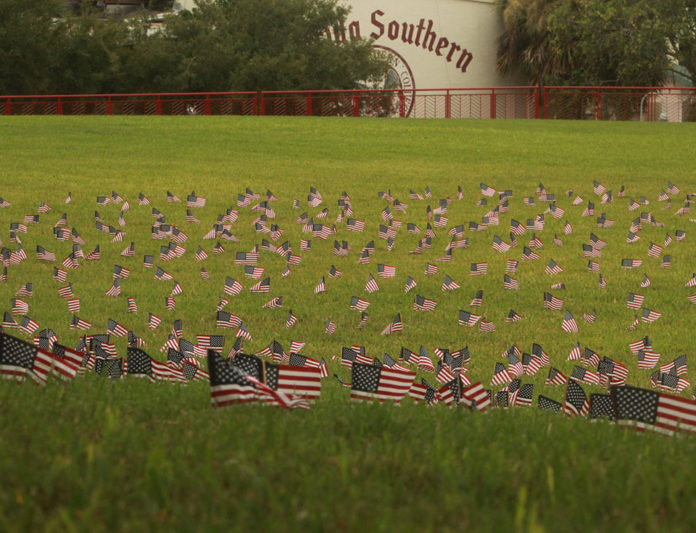
Salvatore Ambrosino
On the late evening of Sept. 10, 11 students spent an hour planting flag after flag in remembrance of an attack that would rock the entire world 20 years ago the next morning.
“There are lots of feelings,” Emily Miles said. “It means a great deal to me, especially having family in the military and who are first responders.”
Miles, the President of Florida Southern College Republicans, the campus organization behind planning the memorial, described the feelings of excitement she had while preparing and planting the small American flags on Mr. George’s Green, each flag symbolic of a life lost during the attack on the World Trade Center on Sept. 11, 2001. Then, as nearly 3000 flags began to loom over nearly half the massive field outside Allen Spivey, she says the excitement turned to sadness.
“It was humbling knowing that every flag placed was a life lost on that day,” FSC College Republicans member Phillip Roney said. “Each one of those flags represented a family, spouse, children or parent who lost a loved one that day.”
Roney says he lost track of time planting flags, and when he looked up at the flags, which had been planted every year as far as he can recall, he was frustrated and disappointed in a new way.
“Disappointed that 20 years later, we handed Afghanistan back to the parties who supported those responsible. I think with the withdrawal of our military in Afghanistan the meaning of 9/11, instead of being in remembrance, is going to serve as a warning. A warning of what the people we just set free are capable of,” Roney said.
On Aug. 26, nearly two decades after the attack, the bombings of Kabul airport killed over 100: at least 90 Afghans and 13 U.S. Service Members who were evacuating Afghanistan as the Taliban laid siege to its capital. This marked a bloody and poignant end to the U.S. 20-year occupation of the country. In addition to the flags, the deceased in Kabul too are remembered by 13 blue vases, decorated in red, white and blue, their name and a self-portrait taped to each one.
“It shows that even twenty years later, we still remember them and mourn their loss,” Miles said. “The Kabul Memorial also shows that remembrance, given their faces and names shown on the vases.”
Associate Professor of Political Science Dr. Bruce Anderson believes not all is lost in the withdrawal of American forces from Afghanistan.
“We risked people over there trying to get people out, that job is a risky, dangerous, bloody job, and we managed to get thousands of people out,” Anderson said. “It was never going to be clean, coming out of Afghanistan.”
But the major lesson in Afghanistan, Anderson says, is for extremist groups like the Taliban to learn. The trillions spent and countless American and Afghan lives lost in the war on terror were never in vain, he says because terrorist attacks the scale of 9/11 have been successfully diverted.
And while many Afghan women and children face religious persecution under the reinstated theocratic regime, the U.S. has left behind infrastructure in the country that will prove difficult, Anderson says, for the Taliban to tear down.
“What’s happened in 20 years; there have been two generations of Afghans that have grown up with the right to education, the right to voice their complaints, and the right to organize, and the Taliban have to deal with that,” Anderson said.







